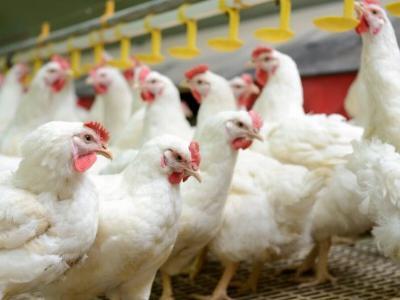New broiler breeders feed recommendations developed

Genetic changes in broiler breeders mean that their body weight gain, feed conversion ratio and meat yield over time have gradually improved. However, broiler breeder management techniques, such as feed allocation and body weight targets, have not kept up with these changes.
As a result, broiler breeders are increasingly suffering from feed and nutrient restrictions that are detrimental to their welfare and have a negative impact on their performance later in life.
Photo: Shutterstock
Feed restrictions in critical development phase
The highest feed restriction in broiler breeders occurs between 8 and 16 weeks of age which makes this phase critical during development. Since feed restriction conditions prevent certain growth-, metabolic-, reproductive- and health-related problems, the growth curves provided by the primary breeder companies have been recommended as the most welfare-friendly alternative to ad libitum feeding. However, this can result in considerable feelings of hunger in the birds, which has been an increasing concern from an animal welfare viewpoint.
The potential to reduce the degree of feed restriction and feelings of hunger has been assessed with contrasting results, for instance, through diluted diets.
Broiler breeder feeding strategy
Trouw Nutrition is aware of the potential impact that genetic improvements can have on broiler breeder nutrition and management, and has therefore conducted a series of trials to develop a new broiler breeder feeding strategy.
The broiler breeder feeding strategy project was developed to study the effect of diluted (low density) diets in combination with high body weight (BW) targets, as strategies to increase feed allowance and to reduce the negative effects that occur from current feed restriction practices.
Rearing phase studies
The 2 rearing phase studies were conducted to study the effect of diet dilution and higher body weight targets throughout rearing (0-19 weeks old) on breeder pullets. Trials were designed as 2x2 factorial designs to determine the effect of 2 different diets (standard versus diluted) and 2 different breeder target body weights (standard versus higher BW) and their possible interaction (Table 1). Each treatment had 5 replicates of 170 and 150 breeder females/pen, 3,400 (5.6 females/m2) and 3,000 (5.0 females/m2) birds were tested.
| Treatment | 1 | 2 | 3 | 4 |
| Diet | Std | Std | Diluted | Diluted |
| Target BW, g | Std* | Higher | Std* | Higher |
The target body weights were achieved by using different diets which resulted in 4 varying amounts of feed offered. Time spent eating was significantly increased (P<0.05) when birds were reared to heavier target body weights. birds that were fed diluted diets spent more time eating compared to the birds eating the standard diet (p><0.0001).>
Feed consumption measured
The feeding rate test (Figure 1) measured the amount of feed consumed over a period 2 minutes under the normal restricted regimen or after a period of ad libitum feeding. The level of hunger is reflected in the speed of eating. The less feed consumed within a certain time, the lower the perceived hunger level. Birds fed diluted diets were statistically (P<0.05) less motivated to eat under the standard restricted regimen compared to the birds fed with the standard diet. the differences demonstrated that birds were less hungry (i.e., food motivated) when fed the diluted diet as they ate 40% less feed on average (35-45%).>
Figure 1 - Feeding rate test results for RP-6 (mash).
Behavioural observations were also performed in the two trials. Pullets fed diluted diets and pullets growing to get a higher BW consistently showed less stereotypic behaviour (pecking) related to fixed pecking elements (Figure 2). These differences could be attributed to an increase in feeding time (as observed in diluted diets) and could corroborate the observation that breeder pullets eating diluted diets are grown with a better standard of management in terms of animal welfare.
Figure 2 - Effect of diet and target BW on fixed pecking elements stereotypic behaviour.
Conclusions and recommendations
In summary, using diluted diets during the rearing phase significantly improves animal welfare. Birds spend more time eating, which leads to less stereotypic behaviour related to pecking. Rearing breeder females to heavier body weights, seems to be a positive strategy in terms of improving breeder welfare, as the feeding rate test response was larger in relation to fixed pecking elements.
A combination of heavy body weight targets and diluted diets appears to be the most reliable strategy to increase the amount of time spent eating, as well as to reduce eating motivation and stereotypic pecking behaviour. Using diluted diets (independent of the target body weight) reduced the motivation to eat and increased the time that breeder females were eating. When crumble diets are used, the impact on the time spent eating is much lower than with mash diets. This suggests that mash diets are advisable when trying to increase the amount of time spent eating.
Improving welfare and performance
Developed by Trouw Nutrition, the broiler breeder feeding strategy concepts can improve the welfare and performance of your breeders. The NutriOpt Broiler breeder recommendations and calculator will allow you to implement these feeding strategies according your current breeder nutritional program. Contact a Trouw Nutrition representative near you to discuss how to put NutriOpt services and tools to work for you.
References available on request.
Tools

Phối trộn thức ăn chăn nuôi

Pha dung dịch thủy canh

Định mức cho tôm ăn

Phối trộn phân bón NPK

Xác định tỷ lệ tôm sống

Chuyển đổi đơn vị phân bón

Xác định công suất sục khí

Chuyển đổi đơn vị tôm

Tính diện tích nhà kính

Tính thể tích ao


 South Korea: Hybrid breed securing chicken success
South Korea: Hybrid breed securing chicken success  Effects of post-hatch brooding temperature on broilers
Effects of post-hatch brooding temperature on broilers